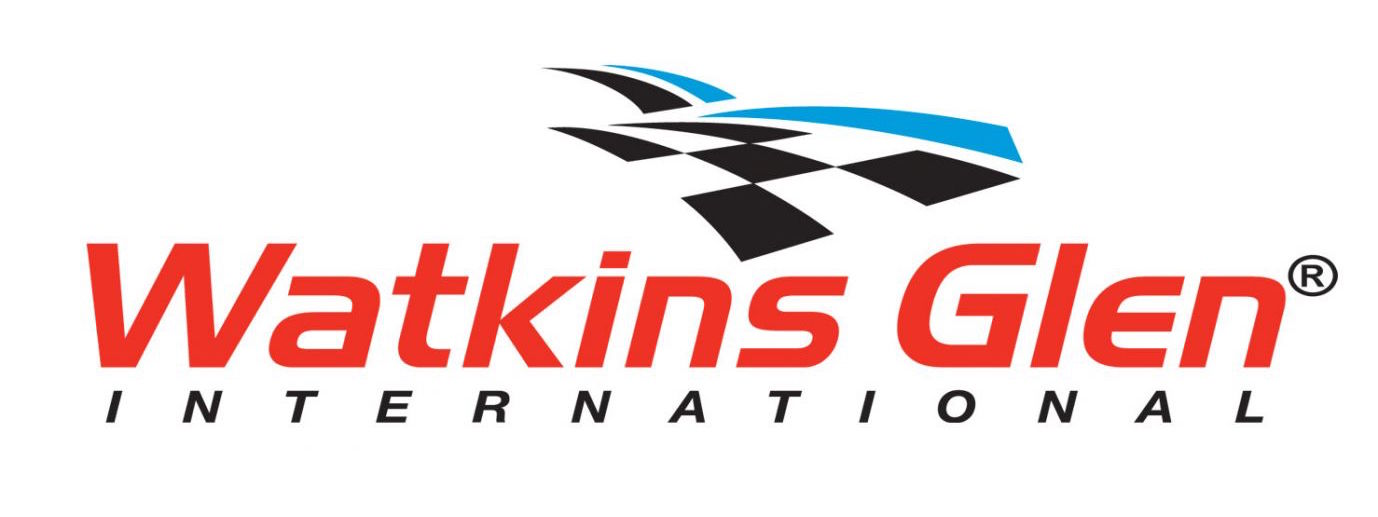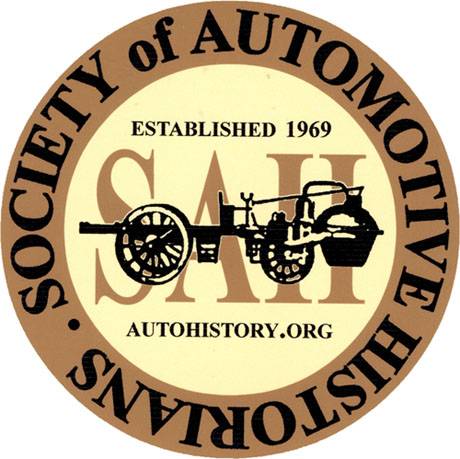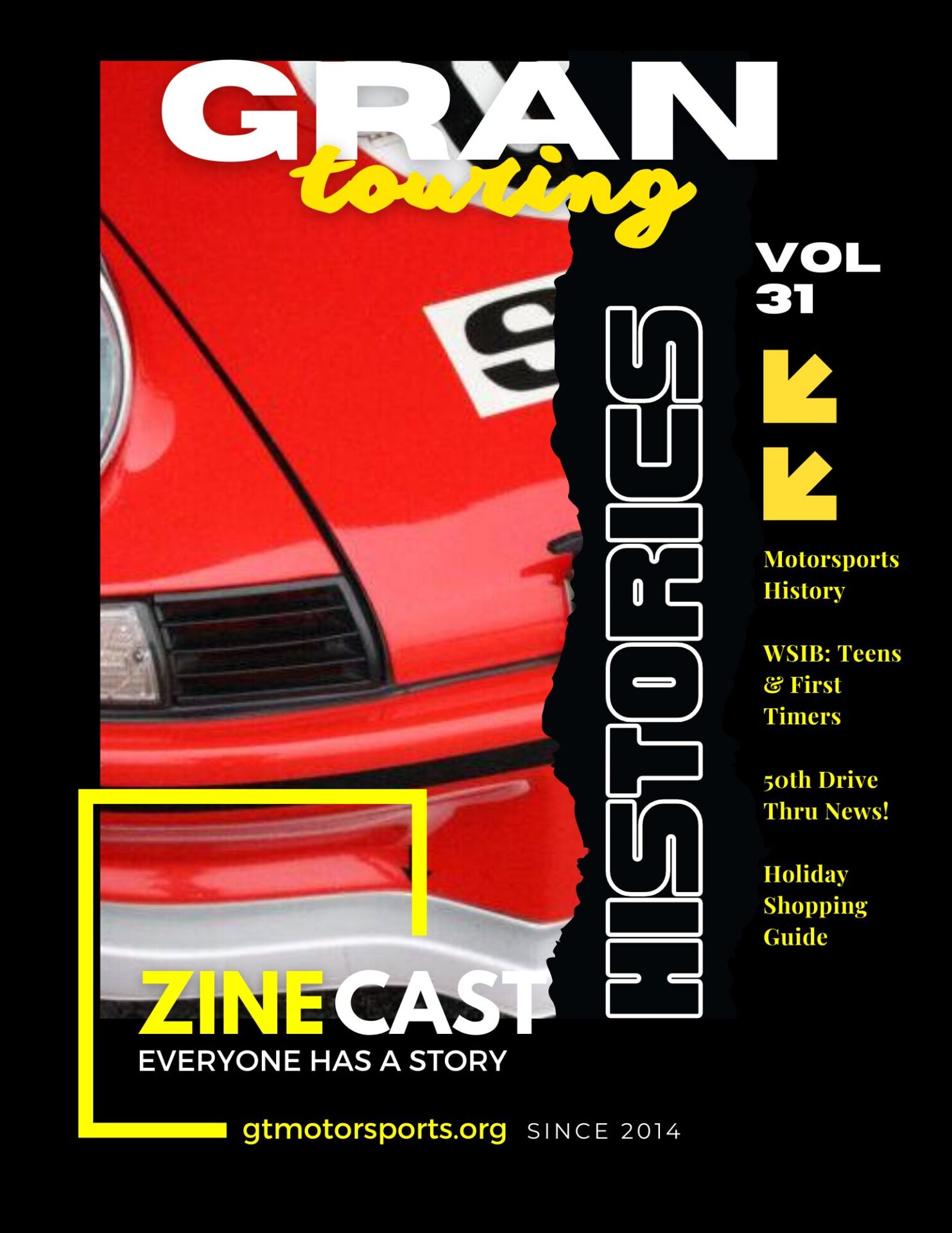Skip McGoun examines Formula One on-track and on-vehicle sponsorships through the post-WWII period to show the evolution of the cultural appeal of the series.
Tune in everywhere you stream, download or listen!
 |  |  |
- Bio
- Notes
- Transcript
- Livestream
- Learn More
Bio

Elton G. “Skip” McGoun is an Emeritus Professor of Finance at Bucknell University and a former visiting professor at the University of Donja Gorija in Montenegro. He has presented and published on both finance history and culture and automobile history and culture and served as area chair of the Vehicle Culture Section of the Popular Culture Association.
Notes
Transcript
[00:00:00] Brake Fix’s History of Motorsports series is brought to you in part by the International Motor Racing Research Center, as well as the Society of Automotive Historians, the Watkins Glen Area Chamber of Commerce, and the Argettsinger family.
Follow the money. Formula One’s financial support as cultural indicator. By Elton G McGowan, Elton Skip McGowan is an emeritus professor of finance at Bucknell university and a former visiting professor of the university of Montenegro. He has presented and published on both finance history and automobile history and culture and served as area chair of the vehicle culture section of the popular culture association.
Skip examines formula one on track and on vehicle sponsorships through the post world war two period to show the evolution of the cultural appeal of the series. The title of this presentation is Follow the Money, which is a very familiar investigation approach. You know, if you really want to know [00:01:00] what’s going on beneath the surface.
follow the money. My observation has been that within motor racing, at least one transaction that appears to be ubiquitous is pay and display. So on the one hand, you have companies providing racing groups with some form of compensation and exchange. They’re allowed to display their name. It’s impossible to believe that anyone isn’t aware of this phenomenon.
Had they not closed the blinds, you could either look at this slide, or you could look out the windows and see numerous banners and billboards. Now, what’s interesting about this are a couple of things. First is, if you look at historic photos from the French Grand Prix of 1908, there are billboards. And there have always been billboards at races.
If you look at what’s on the [00:02:00] billboards, okay, so this is a Formula One event. You have an advertisement for a shipping company, DHL. You have a large international bank, UBS. You have an insurance company, Allianz, and it looks here like you even have a consumer electronics and appliance company, LG, none of which appear to have any direct connection with the company.
Motor racing. And in fact, I have to admit, I’ve been looking out the window since I’ve been here. And I can’t figure out what go bowling has to do with motor racing either. Another location for advertising now is on a tire. This was apparently a relatively recent phenomenon. I mean, we had billboards and banners for a long time.
And it took quite a while before we started seeing anything like this. And it appears to have started out, and this is based upon just looking over some historical photos, with [00:03:00] just a small name on the chest. Kind of like, I think, Eric was wearing yesterday with Pirelli. And then it seems that it’s evolved into something that’s pretty extraordinary from a fashion point of view or a functional point of view.
I’ll go back to this. And I noticed Eric is kind of following this trend this morning. I noticed at least two, Mobile and Porsche. Finally, what everyone has observed after it became legal in the late 60s, we see the logos and names on the automobiles pretty much everywhere it’s possible for them to be.
And again, as with the attire. It’s a little hard to imagine just what the point of something like that is. You know, it’s clearly not something that could ever be seen from any sort of distance. The location of these advertisements really does pose some interesting questions. Why do companies do this?
Obviously, they think that they must be obtaining [00:04:00] some sort of benefit from it. What are the potential benefits that a company might receive from these displays? The obvious one is kind of a traditional marketing benefit, attract new customers. Without having interviewed the folks at Martini and Rossi, this was one of the earliest consumer products to be advertised in Formula One.
And one of the assumptions, or at least part of my speculation, first of all, they’re an alcoholic beverage company. Perhaps they assumed that the audience for Formula One consisted of people who drank alcoholic beverages. You know, which may not be an inappropriate stereotype at the time. However, they weren’t drinking their alcoholic beverages.
Perhaps they thought that by advertising in Formula One, they could convince some of those folks in the stands to give a different drink a try. Okay, so attracting new customers. A second, more or less traditional marketing rationale is to [00:05:00] retain current customers. It’s very difficult for me to believe that anyone in the audience for this Formula One event did not know about Red Bull.
and had not already made a decision whether to drink Red Bull or not. However, you can imagine that maybe what Red Bull is looking for in something like this is that if the folks in the audience are fantasizing taking the checkered flag, you know, standing on the podium, even though they don’t have the car, they could have a can of Red Bull and that this can of Red Bull becomes part of this image, part of this fantasy.
And maybe they might have more than one, hopefully not so many that they’re going to have heart seizures. Now, I took a look at Google Scholar to see if any work had been done in this area and it appeared to me that most of what people have written about has been more or less traditional. You look at sponsorship of Formula One, you see [00:06:00] if revenue increased, if the stock price increased, if brand awareness increased.
It was very, very conventional. I think there are different benefits from something like this that perhaps explains some of the questions I posed earlier. Now I’m calling this social benefits, and if you want to kind of summarize this in a smaller phrase, it’s the opportunity to hang with the cool kids.
So you sponsor a Formula One team, you know, you get to shake hands with the drivers, you get to pose for pictures with them, you get invited to attend the receptions, okay, there are certain benefits to that. These benefits might be for you personally. Keep in mind, I mean, these are companies. Presumably they do have to answer to investors.
But of course, this is an opportunity to take clients and customers along with you. And something like this would be very, very impressive. And I use this as an example. I don’t know if any [00:07:00] of you have heard of Footwork, but Footwork was a Japanese logistics company. And like some of these other sponsorships that you see, it’s really hard to see any really direct connection with Footwork.
Formula One racing, but on the other hand, you can imagine that the customers of footwork would be fans of racing and would be interested in going to these events and having their photos taken with the principles. Another benefit, and I may be. Mistaken in referring to this as political benefits. But the idea is that there’s something else going on, not necessarily related directly to business activities.
Early on, there was certainly a very significant nationalism component to racing. So you could see in a situation like that, an Italian company might want to be showing its patriotism or its political commitment by advertising at an event like that. or advertising on a vehicle in that event. Another one, and [00:08:00] this occurred to me when I was watching the films on Thursday night, you know, we had the Sprint cars with a lot of advertisements on them of companies I had never heard of.
And I thought, well, maybe it’s kind of a way for the company to show its kind of more personal support. For a customer, okay, so that they’re willing to donate in a way to their venture and not just sell them a product. Of course, you could also look at this as being kind of a product discount as well.
But the reason I’ve used Parmalat here is that Parmalat is an Italian, I believe, dairy products company. And again, you’re thinking like, you know, what’s the connection? And I think maybe at this time a Parmalat was trying to become a conglomerate. They wanted their name to be known to potential investors, you know, when they’re looking to finance their acquisitions.
So this is a way of getting their name out there. That may seem a little elusive, but I’ll explain a little more in just a second. And another one, and I think this is becoming increasingly important, is the [00:09:00] idea of brand image. So we have The company Palantir, which as near as I’ve been able to figure out, is a data mining company trying to extract something from large databases.
I’ve never heard of their name in conjunction with motor racing. Usually Palantir is associated with the Department of Homeland Security, with a central intelligence agency, but here they are. Talent here. Ferrari team partner. Interestingly, two days ago I was looking at the CNN website and there was an identical banner on the website to this.
Same photo, same everything, different company. But again, a technology company. One thing that I’ve looked at in the past is the importance of making something tangible. Humans deal with physical objects. And obviously a company like Palantir is intangible. And I’m wondering if making the technology [00:10:00] association with Ferrari gives them some sort of visual substance or visual picture to their clients and customers.
Let me digress just a little bit. I had a friend from Germany visiting a week ago, and I told him I was coming up to the conference and he said, Oh, what are you going to do? And I’m making a presentation and I told him about the presentation. So he told me a story. My friend is with a German biotech company in Munich.
This biotech company, it’s very small, it has a very specialized product. What they produce are delivery systems for drugs. You know, drugs can’t all be administered in the form of a pill. It can be a very, very. very difficult process to get the chemical into the body and get it to the right place. And this is what his company does.
So, the customer for his company are drug companies. So, they hire this company to develop delivery systems for their new experimental drugs, which is [00:11:00] really way far removed from anything individuals are familiar with, and certainly far removed from sport. Now, he was able to use company money to make a contribution to a participant in a race called, and I think it’s called Funderglob.
It’s a solo around the world sailing race. That occurs every four years. One of the reasons I think he made this contribution from his company, he obviously had the influence to do this, is that he’s a sailor. So he kind of liked the idea. But the other reason is, Fond du Globe, I understand, is largely a French So most of the contestants are French, but it’s held every four years.
And four years ago, a German contestant participated and did really well, apparently ended up in the top five out of about 30. And this got huge publicity within Germany. And he thought it might be good to sponsor this [00:12:00] race because another German who was from Bavaria was going to compete. What’s interesting is I don’t know that he anticipated the consequences, but one thing that happened is that as a result of the sponsorship, his company’s representative in France, was invited to a reception where she was photographed with the German contestant in this race.
And this photo ended up prominent in German media. You know, saying, okay, here’s a representative from Sirion Biotech. So, that answered my question as to what the point of all those things on the jackets were. Is it so when someone gets photographed with a driver, they can see on the driver the logo for their company.
Now, the other interesting thing about this story [00:13:00] about my friend is that at the time They were in the process of kind of selling themselves. They were looking for a larger company to take them over. And what he found was their association with this race turned out to be significant. Potential acquirers that they were talking to thought it was pretty cool that the company was associated with this race.
And the thing is, you never know what people are going to bond over or what’s going to be an interesting topic of conversation. So rather than having to talk about antibodies, they were able to talk about I’m going to talk a little bit about sail racing, that story that he told me really gave me some insights into what might really be going on here, that this association can have very valuable, yet very indirect benefits, so that all of those little logos.
on the car are not going to be visible to [00:14:00] customers if any customer ever cares about them, but they provide other downstream benefits that can be extremely valuable. I thought, well, it seems as if there’s an evolution of sponsorships and advertising. It’s kind of gone through a series of changes.
Originally, racing was an important means of advertising the automobiles themselves. But what I found to be interesting here is that in the 1950s, that really wasn’t so much the case. Maybe it was because the cars had deviated so much from anything that people could actually purchase. So if you look at photos from Formula One cars from the 1950s, I saw only two, maybe three.
that had a logo, and it wasn’t very prominent. You know, Mercedes had the star, Maserati had the trident in the grille, and I think I saw a Ferrari logo. The only other thing was, you could spot the Gordinis by the shape of [00:15:00] the grille. They weren’t really advertising the car so much, but as you can tell from the billboard in the background, most of the advertising had to do with various sorts of automotive products.
Petroleum products, tires, spark plugs, those sorts of things. The next stage was really Tobacco advertising. Now, I think there were two reasons for this. One reason is there were fewer and fewer places where tobacco was allowed to be advertised. And in fact, in some cases, it wasn’t even allowed to be advertised on the automobiles.
In some countries, tobacco companies are looking for a place to advertise their product. Here’s where the stereotypes might come in. You know, I mentioned before, stereotype that maybe the Formula One audience at the time Well, maybe there was also a stereotype that the Formula One audience at the time was more likely to smoke than the general population, whether that was accurate or not.
So they had to find someplace to advertise. They chose this possibly because of the audience and also [00:16:00] because they were able to paint the car to look like their pack of cigarettes, which was pretty exciting. And I don’t know of any cigarettes that were green. Then As Formula One apparently became more popular and had a much broader audience, you started seeing advertisements for generic consumer products.
And by generic, I mean did not necessarily appeal to a unique market segment. That pretty much most people would be in the market for this sort of thing. You know, most people would be out and thinking about purchasing a camera, for example. Then from there, It kind of moved more into upscale products.
They were targeting what would probably consider maybe more wealthy people. Okay, so you see HSBC advertising. You see WorldCom advertising. Again, I’m not sure at the time how many of WorldCom’s products actually were under the name WorldCom. People purchase cell service. People purchase telephone service.
I don’t know if they know about WorldCom. And I don’t know [00:17:00] much about beer. I always associated BEX with being a little cut above. This was not bug. So we see them advertising more upscale consumer products. And then, of course, what we see nowadays is astonishing, is advertisements for technology companies.
And again, you can maybe make an argument that these were suppliers in some form or another. I’m not so sure. Okay, so in this case, you do see Palantir. You see Amazon Web Services. I looked some of these up, you know, one was like a Swiss cloud computing company. Okay, so these are companies you’d pretty much for the most part never heard of, kind of like Syrian biotech.
So I saw this as being kind of a progression of products that were being sponsored and wondered what the connection was between that and the audience, or at least that and the company’s perception of the audience. So do the changes in sponsorship correlate with changes in [00:18:00] the Formula One audience and kind of the cultural position of Formula One?
I thought, well, let me see if I can quantify that in some way, and honestly, I don’t know if I had, but what I was able to do was find a Wikipedia site where someone had looked at every Formula One team, and by year, they had the constructor, and that’s how it was listed. Then they identified what they called, at various places, the main sponsor, the delivery sponsor, or the principal sponsor.
And then they had a list of all the secondary sponsors, which obviously was pretty extensive. So I thought, well, let me see who was committed enough to be a main sponsor for three or more consecutive years. In other words, they really believed in something enough to really make a financial commitment.
And then what I did was I looked through and tried to classify them by industry. Take a quick look at who the sponsors were. Now, in [00:19:00] automotive, there weren’t many, where there was some sort of automotive automobile or automotive product associated with a different constructor. Now, I’m guessing that there’s probably a pretty close connection between Stewart and Ford and between HRT and Cosworth.
This is the one where there’s probably no connection. And I’m thinking maybe Infinity was willing to sponsor Red Bull because there was no other automotive name associated with it. Some of the other categories, these are the ones where the constructor was also the principal sponsor. On the one hand, you can see where the automobile company itself, obviously, tremendous resources, is its own principal sponsor, Alfa Romeo, Honda, Lotus, Mercedes Benz for a time, Renault, and some of the others, you can see, you know, some of the more Are less well known constructors.
Apparently couldn’t get another sponsor. So ended up being the principal sponsor themselves. [00:20:00] Here we have the consumer electronics sponsorships. Now again, the idea is principal sponsor three or more consecutive years. General consumer products. And it doesn’t appear to be any particular product category here.
It’s quite a wide variety of companies, you know, many of which I never heard of. Financial companies. Call this oil and chemicals. Actually, most of it’s petrochemicals. There are a few. I think this is a kind of a sugar company. I think Corto’s, you know, is more diversified products. But, you know, notice most of them are petrochemicals.
Technology companies. Tobacco companies. And here you can see, like, Marlboro, for example, sponsored in a wide variety of teams for extended periods of time. And, like, Imperial Tobacco was there for Gold Leaf, but then was there for John Player Specials. You know, there was some sort of break between these, so they didn’t sponsor for a while, and then did.
[00:21:00] transportation companies or logistics companies. So what? I’m not even going to try to necessarily make sense. You can look at these and you can see if this really can have any connection. Obviously, this was very preliminary, okay? So, most of them, constructors, tobacco and petrochemicals, We’re the largest sponsors, then you move into kind of consumer products, and now later into technology and transportation, the average beginning for these terms was highest for tobacco and general consumer products, and then oil and transportation, and later on financial technology.
More recent phenomenon and finally length of sponsorship. I kind of thought this was interesting is that consumer products tended to stick with team for the longest period of time, but tobacco was pretty loyal constructor. It seemed to me that, you know, you would finance yourself until you could find someone else to [00:22:00] provide the principal sponsorship.
So as I said, I’m not sure if these numbers really justify, however, the claim I’m making is that this evolution of sponsorships correlates with the evolution of F1 as a cultural phenomenon. 1950s, F1 was appealing to a subculture. You know, you look at the folks here, I think there are two women and one child in this photo.
Basically, it’s a lot of guys, many of whom appear to be of the same age. It moved from subculture to more mass cultural. A wider range of people were coming. They were bringing their families. You could fill the stands. So we see the transition from the automotive products and tobacco products to the general consumer products.
This is a transition I find interesting. And honestly, I was thinking, you know, maybe next year I ought to come up and do some [00:23:00] research on the cooling of Formula One. So when did Formula 1 go from being a mass phenomenon to being associated with James Bond? So this was where it kind of took the leap from the general consumer products into kind of the higher end products.
Interestingly, Formula 1 now is being used as a backdrop for fashion. It clearly has become very high end and very fashionable, although it does not look as if this has led to fashion sponsorships yet. So you don’t see fashion companies putting their name on the vehicles, but of course, what you do see more than anything else now is this formula.
One is the epitome of technological sophistication, and a lot of companies are taking advantage of that. Making the association and as I suggested giving some sort of tangible image to what is for the most part an intangible and in some cases almost incomprehensible product. It took [00:24:00] me a while before I ever imagined what Palantir did.
So, I think there’s something here. Now, we just saw a presentation which was a long series of clear violations of the statistical principle that correlation does not imply causation. Just because two things happen together doesn’t mean that one caused the other. In this case, I think that may be true.
The audience for Formula One, or at least the stereotypes of the audience for Formula One, or how Formula One is viewed culturally, then leads companies to exploit that with appropriate sponsorships. Therefore, if we’re interested in seeing where this is within the culture, we can look at this in order to do it.
Thank you very much.
Comment. Regarding sponsorship, you mentioned that Marlboro is there again and again and again. I get the impression that you don’t have a [00:25:00] sponsor ever sponsoring multiple teams in the same season. Is that correct? And if not, why not? I mean, it seems like you’d want your name splattered everywhere. You know, Marlboro never sponsored more than one car at the same time.
You’d mentioned you, uh, hadn’t seen a green car with tobacco sponsorship. Well, in North America, Cool Cigarettes was a major sponsor for almost a decade in Formula Atlantic and, uh, CART IndyCar. You started out talking, you mentioned the Go Bowling. I had a chance to interview the Go Bowling folks in August.
Demographics is their big interest in NASCAR because their demographic in bowling are very similar to demographics of what they find. In NASCAR. And so that’s why they come. And it’s not just about being on the signage or on a car. They do what’s called activation, which they bring a bowling alley here [00:26:00] and set it up and let people get involved and the clothing and that sort of thing.
But yeah, it’s not just about your name on the car. It’s what they call activation. and getting people involved and out to the track. You talked about cigarettes and alcohol sponsorship in the 70s. And you talked about, you know, the demographic, who they’re trying to attract. I think it’s also affected the memory of that era as well.
In my social media streams, I’m always getting these pictures of James Hunt smoking and drinking. It seems to be that when people think nostalgically about that era, It’s the smoking and drinking and, you know, leading to guys like Hunt being a little overrated. So anyway, I hope that doesn’t offend anyone.
Um, he kind of lucked into a championship, but that’s another story. But I think it’s also affected the memory. So not just the image of the time, but even how we think about the past. That’s wonderful research, Skip. You’re doing some great stuff there. I have a question about the role of the individual.
Like, we [00:27:00] see this in NASCAR a lot. A driver will come to a team with a sponsor, and that’s where they get their job. And it’s to the point where drivers will get fired because somebody else comes in with a more lucrative sponsor that’s sponsoring the individual, not so much the team. They’ll sponsor whatever car this guy or woman goes to.
I’m just wondering if you saw that with Formula One. Because I’m thinking of someone like Lewis Hamilton. We were all talking about the fashion industry. He seems to be connected with a lot of high end clothing companies, Tommy Hilfiger, and then like the watch deals that so many see drivers promoting watches that seems to be much more personal than a team or a manufacturer.
So just wondering if. There’s any correlation there. That’s clearly, that’s clearly worth doing. As I said, the source for that information was by Constructor. Call me a slacker. I didn’t go the next step to see what drivers were associated with those vehicles at the time and [00:28:00] then to see whether they had an influence on subsequent sponsorship.
But clearly, that would be worth doing. And actually, there’s a wealth of PhD dissertation material here. There really is. Unfortunately, motorsports could stand to be a much more acceptable topic of academic research. I think we’ve just seen Bernie Ecclestone lectures on Formula One with Jim Miller. Then we got Richard Haynes coming up.
Skip, wonderful presentation. Can’t say enough good things about it. A lot of great comments. Yay.
This episode is brought to you in part by the International Motor Racing Research Center. Its charter is to collect, share, and preserve the history of motorsports, spanning continents, eras, and race series. The center’s collection embodies the speed, drama, and camaraderie of amateur and professional motor racing throughout the world.
The Center welcomes serious researchers and casual fans alike to share stories of race drivers, race series, [00:29:00] and race cars captured on their shelves and walls and brought to life through a regular calendar of public lectures and special events. To learn more about the Center, visit www. racingarchives.
org. This episode is also brought to you by the Society of Automotive Historians. They encourage research into any aspect of automotive history. The SAH actively supports the compilation and preservation of papers. Organizational records, print ephemera and images to safeguard, as well as to broaden and deepen the understanding of motorized wheeled land transportation through the modern age and into the future.
For more information about the SAH, visit www. autohistory. org.
We hope you enjoyed another awesome episode of Brake Fix Podcast brought to you by Grand Touring Motorsports. If you’d like to be a guest on the show or get involved, be sure to follow us on all social media platforms at GrandTouringMotorsports. And if you’d like to learn more about the content [00:30:00] of this episode, be sure to check out the follow on article at GTMotorsports.
org. We remain a commercial free and no annual fees organization through our sponsors, but also through the generous support of our fans, families, and friends through Patreon. For as little as 2 and 50 cents a month, you can get access to more behind the scenes action, additional Pitstop minisodes and other VIP goodies, as well as keeping our team of creators.
Fed on their strict diet of fig Newtons, gumby bears, and monster. So consider signing up for Patreon today at www. patreon. com forward slash GT motorsports, and remember without you, none of this would be possible.
Livestream
Learn More
 If you enjoyed this History of Motorsports Series episode, please go to Apple Podcasts and leave us a review. That would help us beat the algorithms and help spread the enthusiasm to others. Subscribe to Break/Fix using your favorite Podcast App:
If you enjoyed this History of Motorsports Series episode, please go to Apple Podcasts and leave us a review. That would help us beat the algorithms and help spread the enthusiasm to others. Subscribe to Break/Fix using your favorite Podcast App: |  |  |
Consider becoming a Patreon VIP and get behind the scenes content and schwag from the Motoring Podcast Network
Do you like what you've seen, heard and read? - Don't forget, GTM is fueled by volunteers and remains a no-annual-fee organization, but we still need help to pay to keep the lights on... For as little as $2.50/month you can help us keep the momentum going so we can continue to record, write, edit and broadcast your favorite content. Support GTM today! or make a One Time Donation.
This episode is sponsored in part by: The International Motor Racing Research Center (IMRRC), The Society of Automotive Historians (SAH), The Watkins Glen Area Chamber of Commerce, and the Argetsinger Family – and was recorded in front of a live studio audience.
Other episodes you might enjoy
Michael R. Argetsinger Symposium on International Motor Racing History
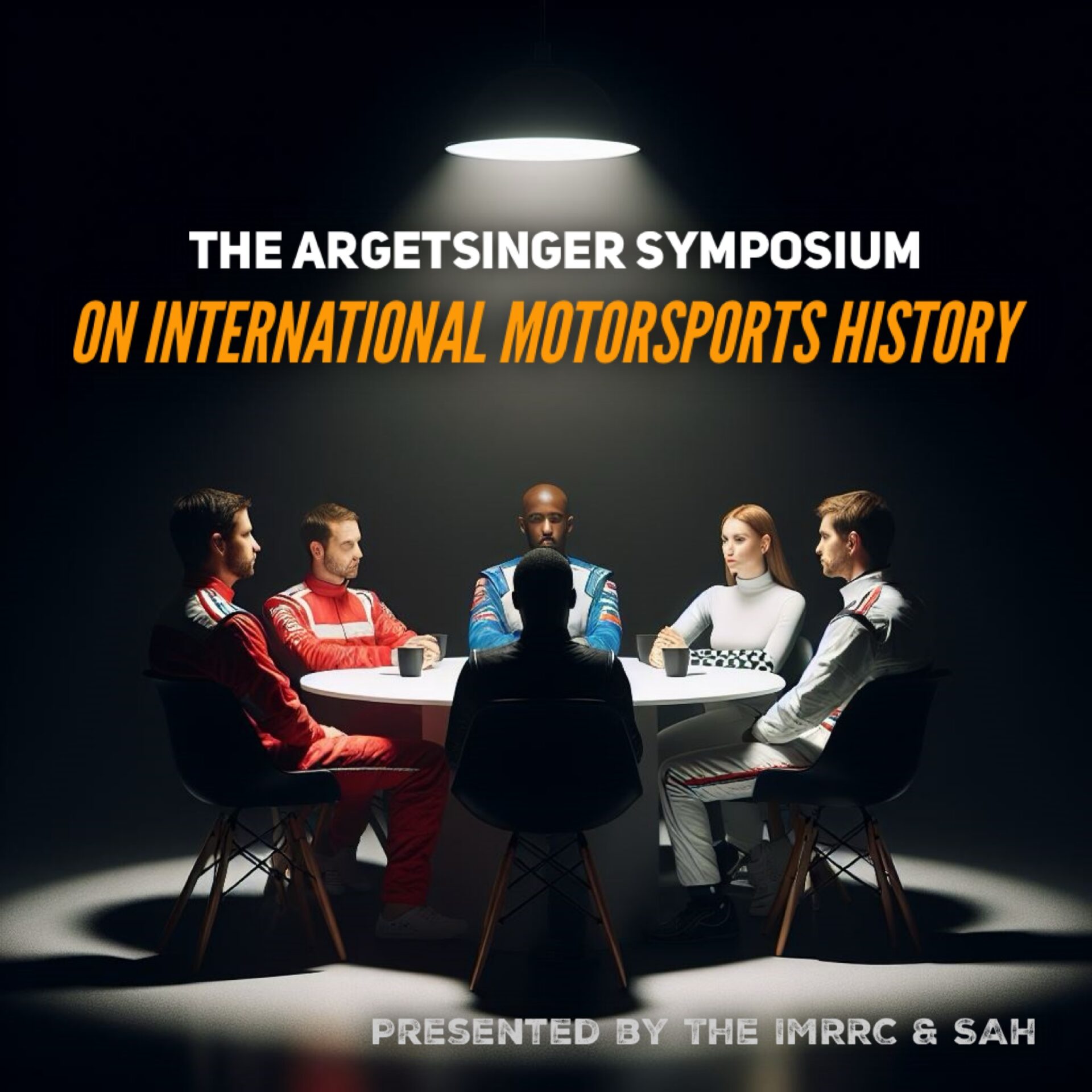 The International Motor Racing Research Center (IMRRC), partnering with the Society of Automotive Historians (SAH), presents the annual Michael R. Argetsinger Symposium on International Motor Racing History. The Symposium established itself as a unique and respected scholarly forum and has gained a growing audience of students and enthusiasts. It provides an opportunity for scholars, researchers and writers to present their work related to the history of automotive competition and the cultural impact of motor racing. Papers are presented by faculty members, graduate students and independent researchers.The history of international automotive competition falls within several realms, all of which are welcomed as topics for presentations, including, but not limited to: sports history, cultural studies, public history, political history, the history of technology, sports geography and gender studies, as well as archival studies.
The International Motor Racing Research Center (IMRRC), partnering with the Society of Automotive Historians (SAH), presents the annual Michael R. Argetsinger Symposium on International Motor Racing History. The Symposium established itself as a unique and respected scholarly forum and has gained a growing audience of students and enthusiasts. It provides an opportunity for scholars, researchers and writers to present their work related to the history of automotive competition and the cultural impact of motor racing. Papers are presented by faculty members, graduate students and independent researchers.The history of international automotive competition falls within several realms, all of which are welcomed as topics for presentations, including, but not limited to: sports history, cultural studies, public history, political history, the history of technology, sports geography and gender studies, as well as archival studies.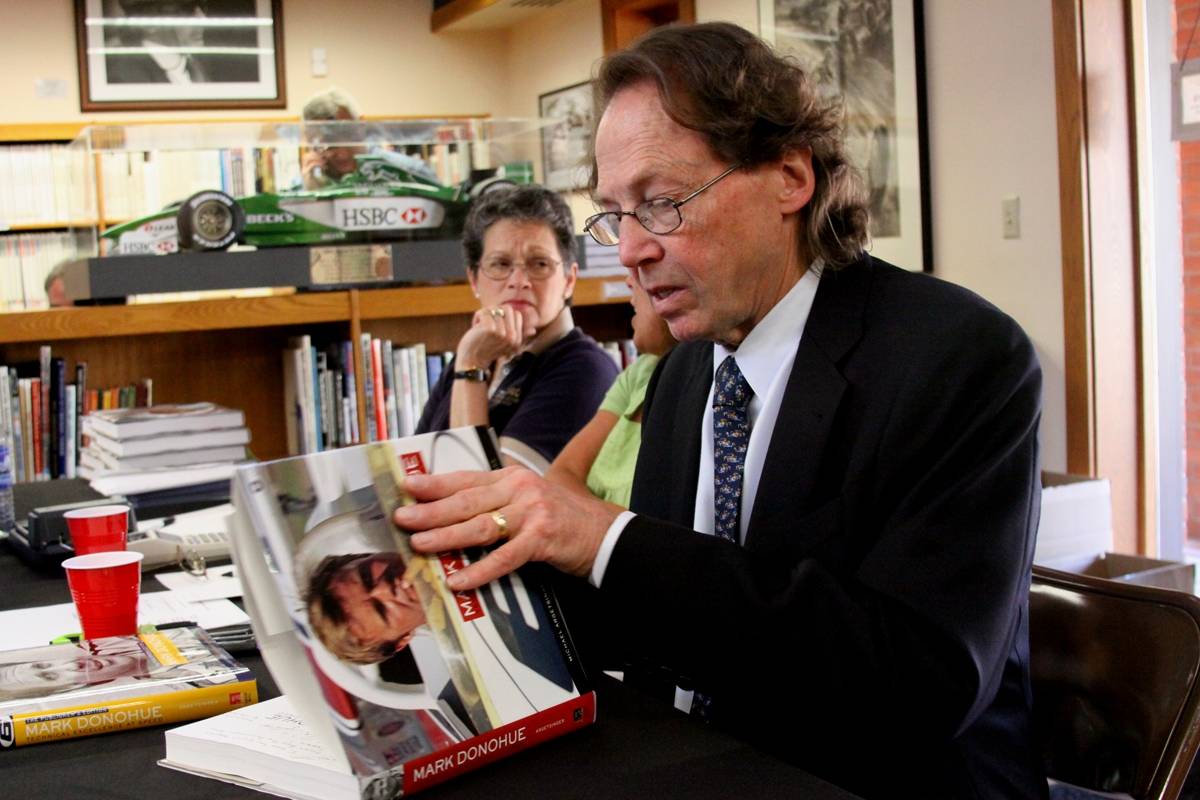 The symposium is named in honor of Michael R. Argetsinger (1944-2015), an award-winning motorsports author and longtime member of the Center's Governing Council. Michael's work on motorsports includes:
The symposium is named in honor of Michael R. Argetsinger (1944-2015), an award-winning motorsports author and longtime member of the Center's Governing Council. Michael's work on motorsports includes:- Walt Hansgen: His Life and the History of Post-war American Road Racing (2006)
- Mark Donohue: Technical Excellence at Speed (2009)
- Formula One at Watkins Glen: 20 Years of the United States Grand Prix, 1961-1980 (2011)
- An American Racer: Bobby Marshman and the Indianapolis 500 (2019)












































